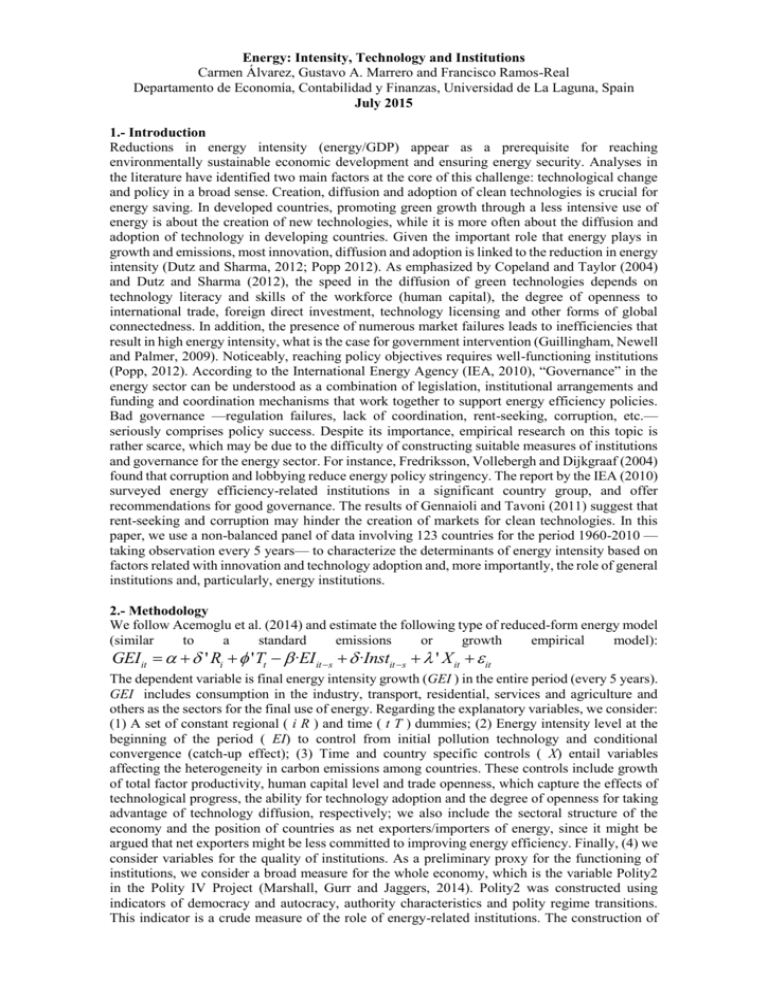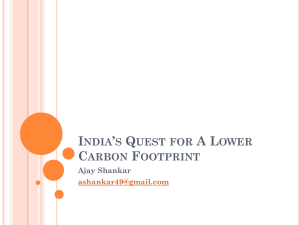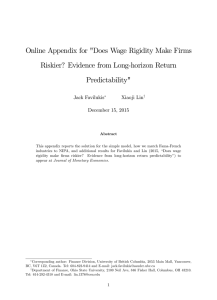View Extended Abstract
advertisement

Energy: Intensity, Technology and Institutions Carmen Álvarez, Gustavo A. Marrero and Francisco Ramos-Real Departamento de Economía, Contabilidad y Finanzas, Universidad de La Laguna, Spain July 2015 1.- Introduction Reductions in energy intensity (energy/GDP) appear as a prerequisite for reaching environmentally sustainable economic development and ensuring energy security. Analyses in the literature have identified two main factors at the core of this challenge: technological change and policy in a broad sense. Creation, diffusion and adoption of clean technologies is crucial for energy saving. In developed countries, promoting green growth through a less intensive use of energy is about the creation of new technologies, while it is more often about the diffusion and adoption of technology in developing countries. Given the important role that energy plays in growth and emissions, most innovation, diffusion and adoption is linked to the reduction in energy intensity (Dutz and Sharma, 2012; Popp 2012). As emphasized by Copeland and Taylor (2004) and Dutz and Sharma (2012), the speed in the diffusion of green technologies depends on technology literacy and skills of the workforce (human capital), the degree of openness to international trade, foreign direct investment, technology licensing and other forms of global connectedness. In addition, the presence of numerous market failures leads to inefficiencies that result in high energy intensity, what is the case for government intervention (Guillingham, Newell and Palmer, 2009). Noticeably, reaching policy objectives requires well-functioning institutions (Popp, 2012). According to the International Energy Agency (IEA, 2010), “Governance” in the energy sector can be understood as a combination of legislation, institutional arrangements and funding and coordination mechanisms that work together to support energy efficiency policies. Bad governance —regulation failures, lack of coordination, rent-seeking, corruption, etc.— seriously comprises policy success. Despite its importance, empirical research on this topic is rather scarce, which may be due to the difficulty of constructing suitable measures of institutions and governance for the energy sector. For instance, Fredriksson, Vollebergh and Dijkgraaf (2004) found that corruption and lobbying reduce energy policy stringency. The report by the IEA (2010) surveyed energy efficiency-related institutions in a significant country group, and offer recommendations for good governance. The results of Gennaioli and Tavoni (2011) suggest that rent-seeking and corruption may hinder the creation of markets for clean technologies. In this paper, we use a non-balanced panel of data involving 123 countries for the period 1960-2010 — taking observation every 5 years— to characterize the determinants of energy intensity based on factors related with innovation and technology adoption and, more importantly, the role of general institutions and, particularly, energy institutions. 2.- Methodology We follow Acemoglu et al. (2014) and estimate the following type of reduced-form energy model (similar to a standard emissions or growth empirical model): GEIit ' Ri ' Tt ·EIit s ·Instit s ' X it it The dependent variable is final energy intensity growth (GEI ) in the entire period (every 5 years). GEI includes consumption in the industry, transport, residential, services and agriculture and others as the sectors for the final use of energy. Regarding the explanatory variables, we consider: (1) A set of constant regional ( i R ) and time ( t T ) dummies; (2) Energy intensity level at the beginning of the period ( EI) to control from initial pollution technology and conditional convergence (catch-up effect); (3) Time and country specific controls ( X) entail variables affecting the heterogeneity in carbon emissions among countries. These controls include growth of total factor productivity, human capital level and trade openness, which capture the effects of technological progress, the ability for technology adoption and the degree of openness for taking advantage of technology diffusion, respectively; we also include the sectoral structure of the economy and the position of countries as net exporters/importers of energy, since it might be argued that net exporters might be less committed to improving energy efficiency. Finally, (4) we consider variables for the quality of institutions. As a preliminary proxy for the functioning of institutions, we consider a broad measure for the whole economy, which is the variable Polity2 in the Polity IV Project (Marshall, Gurr and Jaggers, 2014). Polity2 was constructed using indicators of democracy and autocracy, authority characteristics and polity regime transitions. This indicator is a crude measure of the role of energy-related institutions. The construction of suitable indicators is further commented in the conclusion. The model is estimated with System GMM (Blundell and Bond, 1998), which may handle endogeneity of at least endogenous lagged term, besides other estimation problems. Expected (preliminary) Results Under alternative specifications, we obtain robust result that the lagged degree of democracy is beneficial to reduce and hence improve energy intensity of a country. Results are: Dependent variables: Energy Intensity (final energy consumptio / GDP-ppp adjusted) Method: system GMM, 2 step, lags included as instruments (t-2), robust estimations ln(EI), lag 0.883*** 0.886*** 0.837*** 0.937*** 0.875*** (15.78) (23.51) (22.18) (20.27) (15.44) ln(GDP_pc), lag -0.0299 -0.00883 -0.447 0.0439 -0.00807 (-1.19) (-0.45) (-1.53) (1.12) (-0.24) Polity2, lag -0.134*** -0.164** -0.276** -0.113** (-2.88) (-2.35) (-2.48) (-2.27) ln(GDP_pc)^2, lag 0.0256 (1.48) Agric/GDP, lag 0.00207 (0.71) Indust/GDP, lag -0.00595* (-1.66) Human capital, lag 0.00172 (0.03) TFP growth Num. obs Hansen (p-val) m1-test (p-val) m2-test (p-val) Cross section Num. instruments 731 0.0257 0.0164 0.505 123 41 678 0.247 0.0213 0.310 116 57 678 0.130 0.0259 0.365 116 73 494 0.375 0.126 0.979 108 74 635 0.387 0.0101 0.147 105 73 0.892*** (27.19) 0.00180 (0.07) -0.161** (-2.43) -0.0638 (-1.36) 552 0.376 0.00818 0.0817 91 71 0.929*** (19.89) 0.0715* (1.71) -0.167* (-1.84) 0.908*** (30.56) 0.0168 (0.50) -0.155* (-1.91) 0.00251 (0.88) -0.00428 (-1.35) -0.103 (-1.55) 0.00156 (0.50) -0.00306 (-1.14) 461 0.543 0.00499 0.939 99 86 -0.0901** (-2.42) 391 0.758 0.0000339 0.0812 85 86 Conclusions and further research The construction of suitable indicators of energy institutions and governance is the next step in this research. The report of the IEA (2010) constitutes a good guide for accomplishing this task, since it identifies three main pillars of energy efficiency governance: enabling frameworks (legislation, plans and funding mechanism), institutional arrangements (agencies, resource requirements, energy providers, stakeholders, public-private cooperation and international assistance) and coordination mechanisms (government coordination, targets and evaluation). Our strategy will consist in compiling and analyzing information about as many as possible of these dimensions, and work on them to produce indicators of energy-related institutions. Statistical information about some of the dimensions identified by the IEA (2010) is available in the database Enerdata, namely energy institutions, energy policy targets, energy efficiency law and energy efficiency funds by country. References Acemoglu, D., S. Naidu, P. Restrepo and J.A. Robinson (2014). Democracy, redistribution, and inequality. Handbook of Income Distribution, Vol. 2, 1885-1966. Blundell, R. and S. Bond. (1998). Initial conditions and moment restrictions in dynamic panel data models. Journal of Econometrics, 87(1), 115-143. Copeland, B. R. and M.S. Taylor (2004), Trade, growth, and the environment. J. of Eco. Literat. 42, 7-71. Dutz, M.A. and S. Sharma (2012). Green growth, technology and innovation. WB 5932. Fredriksson, P. G., Vollebergh, H. R. and E. Dijkgraaf (2004). Corruption and energy efficiency in OECD countries: Theory and evidence. Journal of Environmental Economics and Management, 47(2), 207-231. Gennaioli, C. and M. Tavoni (2011). Clean or “dirty” energy: Evidence on a renewable energy resource curse. Working Papers 2011.63, Fondazione Eni Enrico Mattei. Guillingham, K., Newell, R.G. and K. Palmer (2009). Energy efficiency and policy. NBER WP 15031. International Energy Agency (2010). Energy Efficiency Governance. OECD/IEA, Paris, France. Retrieve April 14, 2015, from https://www.iea.org/publications/freepublications/publication/eeg.pdf Marshall, M.G.,Gurr, T.R. and K. Jaggers, K. (2014). Polity IV Project: Dataset users’ manual. C. for Systemic Peace.






